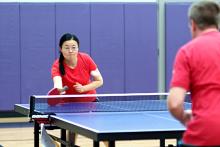The defining element of the sport of Table Tennis is spin. Understanding the types of spin that can be applied to a table tennis ball for any given stroke is imperative for any table tennis athlete wishing to play at a high level.
How many spins can you name?
A Table Tennis ball can be made to rotate on one, two, or even three axis at a time. The first axis of rotation is the horizontal axis and on this axis you can produce either topspin or backspin in varying amounts depending on how you contact the ball. The second axis is the vertical axis and on this axis you can produce lateral spins (right or left sidespin). Finally less understood is the longitudinal axis. Spins along this access do not cause the ball to curve in the air but rather “jump” to the right or left when the ball strikes the table. Spins on this axis are referred to as “deviated” spin.
The answer to the question is , “there are 18 different combinations of spin” that can be applied to a table tennis ball. Keep in mind that while you can combine spins such as topspin with right or left sidespin, you cannot make a ball spin in two different directions.
Here are all 18 different spins that you can apply to a table tennis ball:
- Topspin
- Topspin with Right Lateral Spin
- Topspin with Left Lateral Spin
- Topspin with Right Deviated Spin
- Topspin with Left Deviated Spin
- Topspin with combined Left Lateral Spin and Left Deviated Spin
- Topspin with combined Right Lateral Spin and Right Deviated Spin
- Backspin
- Backspin with Right Lateral Spin
- Backspin with Left Lateral Spin
- Backspin with Right Deviated Spin
- Backspin with Left Deviated Spin
- Backspin with combined Left Lateral Spin and Left Deviated Spin
- Backspin with combined Right Lateral Spin and Right Deviated Spin
- Right Lateral Spin
- Left Lateral Spin
- Right Deviated Spin
- Left Deviated Spin
Deviated spin by itself does not make a ball travel in a forward direction so it must be combined with lateral spins or topspin/backspin to be effective.
While lateral spins and deviated spins are most commonly used with serves and serve returns, they can be equally effective with almost any stroke in the game. Adding different spin combinations to the ball can help you produce variations in your returns that will make your blocks, pushes, even topspins more effective.
I encourage my students to experiment with producing different spins and varying amounts of spin on all of their strokes. Table Tennis is a game of spin and the more spin you can produce and control the better player you will become.




